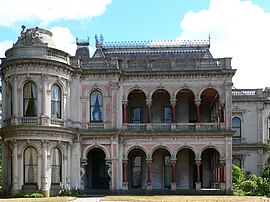Caulfield North, Victoria
| Caulfield North Melbourne, Victoria | |||||||||||||||
|---|---|---|---|---|---|---|---|---|---|---|---|---|---|---|---|
 Labassa, Manor Grove | |||||||||||||||
| Coordinates | 37°52′23″S 145°01′30″E / 37.873°S 145.025°E | ||||||||||||||
| Population | 15,269 (2016 census)[1] | ||||||||||||||
| • Density | 3,640/km2 (9,420/sq mi) | ||||||||||||||
| Postcode(s) | 3161 | ||||||||||||||
| Area | 4.2 km2 (1.6 sq mi) | ||||||||||||||
| Location | 11 km (7 mi) from Melbourne | ||||||||||||||
| LGA(s) | City of Glen Eira | ||||||||||||||
| State electorate(s) | Caulfield | ||||||||||||||
| Federal division(s) | Melbourne Ports | ||||||||||||||
| |||||||||||||||
Caulfield North is a suburb in Melbourne, Victoria, Australia, 11 km south-east of Melbourne's central business district in the local government area is the City of Glen Eira. At the 2011 Census, Caulfield North had a population of 14,554.
It is bounded by Orrong Road in the west, Glen Eira Road in the south, Dandenong Road in the north and Kambrook Road in the east. The suburb contains Caulfield Park - a park of approximately 26 hectares in size, bounded by Balaclava Road, Inkerman Road, Hawthorn Road and Park Crescent.
Caulfield North has the largest Jewish population of any suburb in Australia: 6,522 (according to the 2011 census), representing 45% of its population. The Australian Centre for Jewish Civilisation at Monash University estimates that this is higher, settling on a figure of 7,506, constituting 51.6% of the suburb's population.[2]
History
This section needs additional citations for verification. (April 2011) |
Caulfield North was once the location of many large Victorian mansions on large estates, most of which were demolished and subdivided in the early twentieth century.
A notable survivor is Labassa owned by the National Trust. The mansion was originally built in 1862 and extended in 1873. In 1889 further extensions and lavish refurbishment commissioned by William Alexander Robertson created the present mansion which is of national significance.[3] The house is sometimes used for filming of the ABC's lady detective series Miss Fisher's Murder Mysteries and was one of the filming locations for the 2002 film Queen of the Damned.
Many streets in the suburb were named in the late 1850s after Crimea War locations and people, for example, Cardigan, Canrobert, Inkerman, Alma, Raglan, Redan and Balaclava.
The Caulfield North Post Office was opened on 26 March 1915.[4]
Public transport
Trams service Caulfield North extensively, with a major tram interchange at Balaclava Junction. Tram routes 3, 16 and 64 all service Caulfield North. Caulfield North also contains Balaclava Junction, the only extant grand union in the Southern Hemisphere, a junction where trams can go in all directions from all directions.
Trains connect the suburb to the city via the major transport interchange, Caulfield railway station at Caulfield East (via tram route 3). Trains also connect the suburb to the city through Balaclava railway station (via tram routes 3 and 16).
Notable people
Australian television personality Graham Kennedy went to the Caulfield North State School (now Caulfield Junior College), in Balaclava Road.[citation needed]
Gallery
-
Grimwade House, now part of Melbourne Grammar School
See also
- City of Caulfield - the former local government area of which Caulfield North was a part
References
- ^ Australian Bureau of Statistics (27 June 2017). "Caulfield North (State Suburb)". 2016 Census QuickStats. Retrieved 12 April 2018.
- ^ The Jewish population of Australia: Key findings from the 2011 census Jewish Care. Retrieved on 14 September 2016
- ^ Victorian Heritage Database, HO135 Labassa, retrieved 2 August 2016
- ^ Premier Postal History, Post Office List, retrieved 11 April 2008


